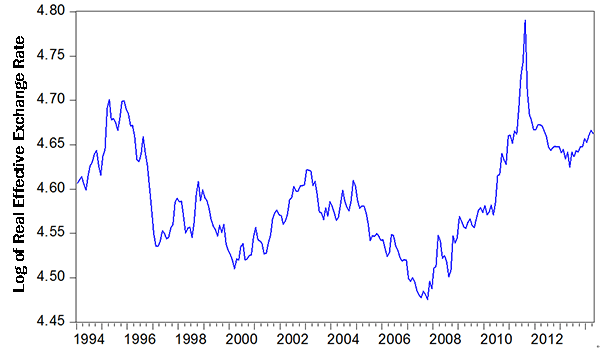| Author Name | THORBECKE, Willem (Senior Fellow, RIETI) / KATO Atsuyuki (Research Associate, RIETI) |
|---|---|
| Research Project | East Asian Production Networks, Trade, Exchange Rates, and Global Imbalances |
| Download / Links |
This Non Technical Summary does not constitute part of the above-captioned Discussion Paper but has been prepared for the purpose of providing a bold outline of the paper, based on findings from the analysis for the paper and focusing primarily on their implications for policy. For details of the analysis, read the captioned Discussion Paper. Views expressed in this Non Technical Summary are solely those of the individual author(s), and do not necessarily represent the views of the Research Institute of Economy, Trade and Industry (RIETI).
International Macroeconomics (FY2011-FY2015)
East Asian Production Networks, Trade, Exchange Rates, and Global Imbalances
The Swiss franc began appreciating in the spring of 2011 as the Eurozone Crisis intensified and Switzerland experienced safe haven capital inflows. In September 2011, the Swiss National Bank announced that the strong franc was multiplying deflationary risks and that it would set a floor of 1.2 francs to the euro. The franc immediately depreciated by 10% (see Figure 1).
Many have argued that because Swiss exports are technologically advanced, exchange rate changes will not affect them. For instance, the International Monetary Fund stated that Swiss "exporting industries may be built around production of very specific items, which are particularly valued for their brands or special characteristics and hence face limited price competition." In this paper, we investigate these issues quantitatively.
We find that Switzerland has the most sophisticated export structure according to both Hausmann et. al's (2007) measure for every year after 1996 and Kwan's (2002) measure for every year after 1980. We also investigate Switzerland's export structure using the Organisation for Economic Co-operation and Development (OECD) classifications. According to this measure, 47% of Swiss manufacturing exports in 2011 were classified as high-tech. This was the third highest in the world. Given its advanced export structure, one might expect Swiss goods not to compete based on price and hence for exchange rate changes to have only a limited impact on exports.
We find that exchange rate appreciations cause a large decrease in Swiss exports. The fact that exchange rates matter for a country with such an advanced export structure runs counter to the claim that high end exports should have low exchange rate elasticities.
These findings may have implications for Japan's trade and exchange rate policies. Some have argued that since Japan exports high value-added products, its exports do not respond to exchange rate changes. However, the evidence from Switzerland indicates that even high end exports can be affected by exchange rates. Thus, Japan should consider following Switzerland and weakening the yen if and when safe haven capital inflows cause the yen to become overvalued.
Figure 1. Swiss Real Effective Exchange Rate

Source: Bank for International Settlements

